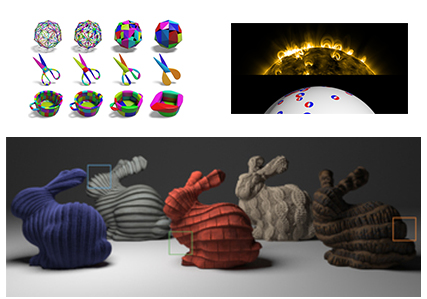News Release
UC San Diego Center for Visual Computing celebrates a strong showing at SIGGRAPH 2022
June 23, 2022: UC San Diego faculty and research teams affiliated with the UC San Diego Center for Visual Computing are well represented, yet again, at SIGGRAPH 2022, which is the top academic venue for the computer graphics field.
 |
| Images related to three of the ten UC San Diego projects being presented at SIGGRAPH 2022. |
"By my count, UC San Diego researchers are on more papers and presentations at SIGGRAPH 2022 than any other school. It's great to be recognized for our world-class research," said Ravi Ramamoorthi, the UC San Diego computer science professor who leads the Center for Visual Computing. Besides Ramamoorthi, UC San Diego faculty with papers at SIGGRAPH include assistant professors Hao Su, Albert Chern and Tzu-Mao Li, all of whom have been hired in the past 5 years, as part of the Center for Visual Computing’s rapid growth. Their research covers a broad range of topics, including physical simulation, realistic image synthesis or rendering, geometry processing, differentiable programming and computational photography.
SIGGRAPH 2022 papers and presentations with UC San Diego / Center for Visual Computing / Department of Computers Science and Engineering affiliations are listed below.
1. Approximate Convex Decomposition for 3D Meshes With Collision-aware Concavity and Tree Search
Project description: Approximate convex decomposition enables efficient geometry processing algorithms specifically designed for convex shapes (e.g., collision detection). We propose a method that is better to preserve collision conditions of the input shape with fewer components. It thus supports delicate and efficient object interaction in downstream applications.
2. Covector Fluids
Project description: We simulate Euler equations for inviscid fluids by using a novel formulation based on covectors. This new formulation is an entirely velocity-based method in the vein of advection-projection methods while emulating vortex methods. This allows for capturing more intricate vortex dynamics and reducing dissipation of energy with low computational overhead.
3. Designing Perceptual Puzzles by Differentiating Probabilistic Programs
Project description: We design new examples of visual illusions like "The Dress" by finding "adversarial examples" for principled models of human perception — specifically probabilistic models, which treat vision as Bayesian inference. To perform this search efficiently, we design a differentiable probabilistic programming language, exposing MCMC inference as a first-class differentiable function.
4. Filament Based Plasma
Project description: We assemble a computational pipeline for procedurally generating the visual appearance of our sun. Using Lagrangian elements, the features of the solar atmosphere are reconstructed at a high level of detail.
5. Neural Jacobian Fields: Learning Intrinsic Mappings of Arbitrary Meshes
Project description: We introduce a framework for deep learning of deformations of meshes. The trained network is highly accurate and produces realistic results and can be applied to meshes of arbitrary triangulations and not a fixed one. We show various experiments such as UV mapping, elastic deformations, and learning to repose humans.
6. Photon-driven Neural Reconstruction for Path Guiding
Project description: We present a path-guiding approach that can reconstruct high-quality sampling distributions using an offline trained neural network. We leverage photons traced from light sources for sampling density reconstruction, which is effective for challenging scenes with global illumination. We further partition the scene space into an adaptive hierarchical grid.
7. Rendering Neural Materials on Curved Surfaces
Project description: Neural material representations address some limitations of traditional analytic BRDFs. However, they still approximate the material on an infinite plane, which prevents them from correctly handling silhouette and parallax effects. This paper proposes neural materials capable of correctly handling such silhouette effects by taking into account the curvature information.
8. Searching for Fast Demosaicking Algorithms
Project description: We present a method to automatically synthesize a Pareto frontier of efficient, high-quality e-mosaicking algorithms across a range of computational budgets. It performs a multi-objective, discrete-continuous optimization which simultaneously solves for the program structure and parameters that best trade off computational cost and image quality.
9. SofGAN: A Portrait Image Generator With Dynamic Styling
Project description: SofGAN is a portrait generator that allows for high-quality rendering with attribute controlling over camera pose, geometry, and texture styles.
10. A Unified Newton Barrier Method for Multibody Dynamics
Project description: We present a simulation framework for multibody dynamics with optimization time integration. Our method naturally supports mixed rigid-deformables and mixed codimensional geometries while providing guaranteed robustness and accurate resolution of frictional contact and a wide range of articulation constraints, including restitution.
Media Contacts
Daniel Kane
Jacobs School of Engineering
858-534-3262
dbkane@ucsd.edu